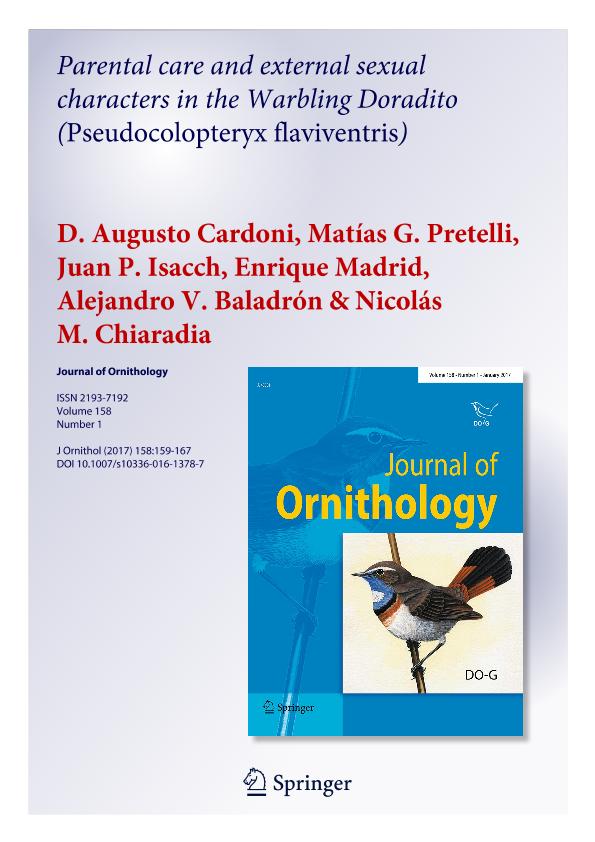Mostrar el registro sencillo del ítem
dc.contributor.author
Cardoni, Daniel Augusto

dc.contributor.author
Pretelli, Matías Guillermo

dc.contributor.author
Isacch, Juan Pablo

dc.contributor.author
Madrid, Enrique Alberto

dc.contributor.author
Baladron Felix, Alejandro Victor

dc.contributor.author
Chiaradia, Nicolas Mariano

dc.date.available
2018-10-11T17:23:29Z
dc.date.issued
2017-01
dc.identifier.citation
Cardoni, Daniel Augusto; Pretelli, Matías Guillermo; Isacch, Juan Pablo; Madrid, Enrique Alberto; Baladron Felix, Alejandro Victor; et al.; Parental care and external sexual characters in the Warbling Doradito (Pseudocolopteryx flaviventris); Wiley Blackwell Publishing, Inc; Journal Fur Ornithologie; 158; 1; 1-2017; 159-167
dc.identifier.issn
0021-8375
dc.identifier.uri
http://hdl.handle.net/11336/62218
dc.description.abstract
Biparental care is the dominant (81 %) form of parental care in birds. The degree of sexual selection and the resulting mating system and parental care type have been determined, in many cases, by inference from external characters of sexual dimorphism. The lack of information and the biological attributes of the tyrant flycatchers (e.g., low sexual dimorphism) make it difficult to determinate the parental care roles in most species. Tyrant flycatchers comprise a diverse bird family, but information on the reproductive behavior of many Tyrannid species is lacking. Our aim was to describe external sexual characters (morphology and coloration) and determine the parental care behavior at the nest in the Warbling Doradito (Pseudocolopteryx flaviventris), especially considering the potential role of sexual differences in relation to parental roles at nest. We studied the parental care behavior during two breeding seasons. Parents were captured to take morphological measurements and a blood sample for molecular sex determination. We found that parental care in the Warbling Doradito was biparental biased toward females, where the incubation was performed exclusively by females and the 74 % of activities of nestling brooding and feeding was performed by females. We also found sexual differences, slight in size and plumage, but more conspicuous in bill color. Despite the relatively slight sexual dichromatism of the Warbling Doradito, the parental care behavior in the nest was biased towards females, and the assistance of males to nestlings was highly variable and was not correlated with either clutch size or increasing nestling mass. Therefore, the evidence presented here suggest that Pseudocolopteryx genus may have an unusual social system, otherwise uncommon in tyrannids.
dc.format
application/pdf
dc.language.iso
eng
dc.publisher
Wiley Blackwell Publishing, Inc

dc.rights
info:eu-repo/semantics/openAccess
dc.rights.uri
https://creativecommons.org/licenses/by-nc-sa/2.5/ar/
dc.subject
Argentina
dc.subject
Dichromatism
dc.subject
Grasslands
dc.subject
Morphology
dc.subject
Nestling Feeding
dc.subject
Pampas
dc.subject
Tyrannidae
dc.subject.classification
Otras Ciencias Biológicas

dc.subject.classification
Ciencias Biológicas

dc.subject.classification
CIENCIAS NATURALES Y EXACTAS

dc.title
Parental care and external sexual characters in the Warbling Doradito (Pseudocolopteryx flaviventris)
dc.type
info:eu-repo/semantics/article
dc.type
info:ar-repo/semantics/artículo
dc.type
info:eu-repo/semantics/publishedVersion
dc.date.updated
2018-10-01T15:26:21Z
dc.journal.volume
158
dc.journal.number
1
dc.journal.pagination
159-167
dc.journal.pais
Reino Unido

dc.journal.ciudad
Londres
dc.description.fil
Fil: Cardoni, Daniel Augusto. Consejo Nacional de Investigaciones Científicas y Técnicas. Centro Científico Tecnológico Conicet - Mar del Plata. Instituto de Investigaciones Marinas y Costeras. Universidad Nacional de Mar del Plata. Facultad de Ciencia Exactas y Naturales. Instituto de Investigaciones Marinas y Costeras; Argentina
dc.description.fil
Fil: Pretelli, Matías Guillermo. Consejo Nacional de Investigaciones Científicas y Técnicas. Centro Científico Tecnológico Conicet - Mar del Plata. Instituto de Investigaciones Marinas y Costeras. Universidad Nacional de Mar del Plata. Facultad de Ciencia Exactas y Naturales. Instituto de Investigaciones Marinas y Costeras; Argentina
dc.description.fil
Fil: Isacch, Juan Pablo. Consejo Nacional de Investigaciones Científicas y Técnicas. Centro Científico Tecnológico Conicet - Mar del Plata. Instituto de Investigaciones Marinas y Costeras. Universidad Nacional de Mar del Plata. Facultad de Ciencia Exactas y Naturales. Instituto de Investigaciones Marinas y Costeras; Argentina
dc.description.fil
Fil: Madrid, Enrique Alberto. Consejo Nacional de Investigaciones Científicas y Técnicas. Centro Científico Tecnológico Conicet - Mar del Plata. Instituto de Investigaciones Marinas y Costeras. Universidad Nacional de Mar del Plata. Facultad de Ciencia Exactas y Naturales. Instituto de Investigaciones Marinas y Costeras; Argentina
dc.description.fil
Fil: Baladron Felix, Alejandro Victor. Consejo Nacional de Investigaciones Científicas y Técnicas. Centro Científico Tecnológico Conicet - Mar del Plata. Instituto de Investigaciones Marinas y Costeras. Universidad Nacional de Mar del Plata. Facultad de Ciencia Exactas y Naturales. Instituto de Investigaciones Marinas y Costeras; Argentina
dc.description.fil
Fil: Chiaradia, Nicolas Mariano. Consejo Nacional de Investigaciones Científicas y Técnicas. Centro Científico Tecnológico Conicet - Mar del Plata. Instituto de Investigaciones Marinas y Costeras. Universidad Nacional de Mar del Plata. Facultad de Ciencia Exactas y Naturales. Instituto de Investigaciones Marinas y Costeras; Argentina
dc.journal.title
Journal Fur Ornithologie

dc.relation.alternativeid
info:eu-repo/semantics/altIdentifier/doi/https://dx.doi.org/10.1007/s10336-016-1378-7
dc.relation.alternativeid
info:eu-repo/semantics/altIdentifier/url/https://link.springer.com/article/10.1007/s10336-016-1378-7
Archivos asociados
